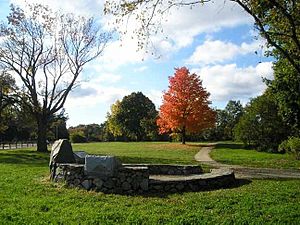Samuel Prescott facts for kids
Quick facts for kids
Samuel Prescott
|
|
|---|---|

Monument at Paul Revere capture site. From here, Samuel Prescott carried on Revere's mission.
|
|
| Born | August 19, 1751 |
| Died | possibly 1777 (aged 25–26) possibly Halifax, Nova Scotia, Canada
|
| Occupation | Physician |
| Home town | Concord, Massachusetts |
| Parents |
|
| Relatives | Abel Prescott Jr. (brother) |
Samuel Prescott (born August 19, 1751) was a doctor and a brave American Patriot. He lived during the time of the American Revolutionary War. Prescott is famous for his part in Paul Revere's "midnight ride." This ride warned people in Concord, Massachusetts that British soldiers were coming. The British wanted to take away guns and gunpowder. Samuel Prescott was the only rider who made it all the way to Concord that night.
Prescott's Early Life
We don't know much about Samuel Prescott's early life. He was born on August 19, 1751. He grew up in Concord, Massachusetts, where his family had lived for many years. Samuel followed in his father's and grandfather's footsteps. He became a doctor, just like them.
Before the American Revolution started, Samuel Prescott was dating Lydia Mulliken. She lived in Lexington, Massachusetts. Her family's home was near Munroe's Tavern. Lydia's older brother, Nathanial, was part of the local militia.
Some people believe Prescott was a "high son of Liberty." This means he strongly supported the American cause. He might have been part of groups like the Sons of Liberty. He may have also carried messages for the Committees of Correspondence. These groups helped spread news among the colonies.
The Midnight Ride
On the evening of April 18, 1775, Paul Revere and William Dawes began an important mission. Joseph Warren sent them to warn Samuel Adams and John Hancock. These leaders were in Lexington. British soldiers were on their way to arrest them. Warren also told Revere to warn Concord. British troops planned to take or destroy weapons there.
Revere and Dawes took different paths. They met in Lexington around midnight. They successfully warned Adams and Hancock, who quickly left. Then, Revere and Dawes continued towards Concord. Their goal was to complete their second mission.
Samuel Prescott was riding home to Concord. He met Revere and Dawes around 1 a.m. on April 19. Revere later said Prescott was a "high son of Liberty." This meant Prescott was someone they could trust. When Prescott heard about their mission, he offered to help. He knew the area well. He thought people would believe a warning from him more easily.
The three riders continued towards Concord. They warned people in several houses in Lincoln, Massachusetts. They knocked on doors to spread the news. In Lincoln, near the Concord town line, British soldiers stopped them. These soldiers were part of a larger group. They were sent to catch any American riders.
The British soldiers captured Revere. But Prescott and Dawes managed to escape. Dawes fell from his horse and went back to Lexington. Prescott, according to Revere, rode his horse towards a stone wall. He jumped his horse over it and rode into thick woods. After riding through woods and a swamp, Prescott reached the Hartwell Tavern. He warned the Hartwell family. They quickly went to warn others. News soon reached Captain William Smith. He was the leader of the Lincoln minutemen. He ordered the town bell to ring. This was a signal for his company to gather.
On his way to Concord, Prescott warned more houses in Lincoln. Soon, other riders joined in to warn more towns. When Prescott arrived in Concord, he told the guard there. The Concord First Parish Church bell rang to alert the town. This way, Prescott finished the second part of Revere and Dawes' mission. In Concord, Prescott asked his brother Abel to ride to Sudbury. Abel was to warn the companies there. People say Samuel then rode to Acton and Stow to spread the alarm. Thanks to Prescott's efforts that night, many minuteman and militia groups were warned. They gathered and marched to Concord. They arrived in time to fight the British Army. Battles happened at the Old North Bridge and along the road to Boston.

What Happened Later
We don't know much about Samuel Prescott's life after the ride. Some historians believe he worked as a surgeon. A record shows a "Dr. Sall Prescott" serving at Fort Ticonderoga in 1776. A soldier from the Revolutionary War wrote in his memories that he was in a British prison. This prison was in Halifax, Nova Scotia. He said a "Dr. Prescott" was also there. According to this story, Prescott died in that prison in 1777. We don't have other proof that this was Samuel Prescott of Concord. But many people believe this is what happened.
Prescott's Legacy
Every year on April 19, Prescott's arrival in Concord is reenacted. This event happens at midnight. Before the reenactment, there is a Patriots' Ball. There is also a parade by modern-day Minuteman groups. These groups include fife and drum units. Prescott's ride through Acton is also reenacted every Patriots' Day. It starts in East Acton. It ends at Liberty Tree Farm. This was once the home of a minuteman named Simon Hunt.
In 1965, the Concord Chapter of the Daughters of the American Revolution placed a special plaque. This memorial honors Prescott. It is located where his home once stood in Concord.


